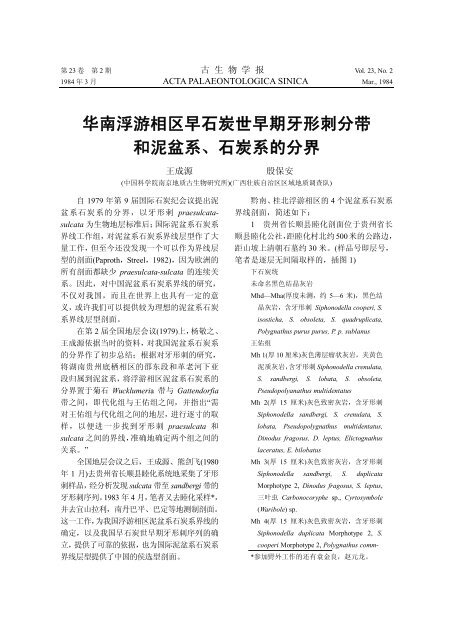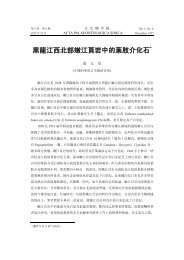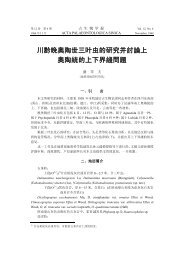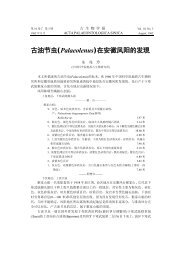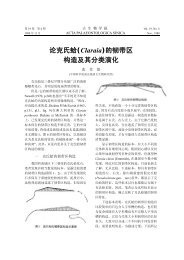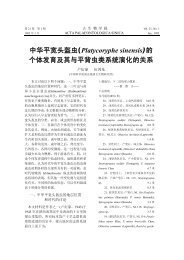华南浮游相区早石炭世早期牙形刺分带和泥盆系、石炭系的分界
华南浮游相区早石炭世早期牙形刺分带和泥盆系、石炭系的分界
华南浮游相区早石炭世早期牙形刺分带和泥盆系、石炭系的分界
Create successful ePaper yourself
Turn your PDF publications into a flip-book with our unique Google optimized e-Paper software.
第 23 卷 第2期 古 生 物 学 报 Vol. 23, No. 2<br />
1984 年 3 月 ACTA PALAEONTOLOGICA SINICA Mar., 1984<br />
华南浮游相区早石炭世早期牙形刺分带<br />
和泥盆系、石炭系的分界<br />
王成源 殷保安<br />
(中国科学院南京地质古生物研究所)(广西壮族自治区区域地质调查队)<br />
自1979 年第 9 届国际石炭纪会议提出泥<br />
盆系石炭系的分界,以牙形剌 praesulcata-<br />
sulcata 为生物地层标准后;国际泥盆系石炭系<br />
界线工作组,对泥盆系石炭系界线层型作了大<br />
量工作,但至今还没发现一个可以作为界线层<br />
型的剖面(Paproth,Streel,1982),因为欧洲的<br />
所有剖面都缺少 praesulcata-sulcata 的连续关<br />
系。因此,对中国泥盆系石炭系界线的研究,<br />
不仅对我国,而且在世界上也具有一定的意<br />
义,或许我们可以提供较为理想的泥盆系石炭<br />
系界线层型剖面。<br />
在第2届全国地层会议(1979)上,杨敬之、<br />
王成源依据当时的资料,对我国泥盆系石炭系<br />
的分界作了初步总结;根据对牙形刺的研究,<br />
将湖南贵州底栖相区的邵东段和革老河下亚<br />
段归属到泥盆系,将浮游相区泥盆系石炭系的<br />
分界置于菊石 Wucklumeria 带与 Gattendorfia<br />
带之间,即代化组与王佑组之间,并指出“需<br />
对王佑组与代化组之间的地层,进行逐寸的取<br />
样,以便进一步找到牙形刺 praesulcata 和<br />
sulcata 之间的界线,准 确 地 确定两个组之间的<br />
关系。”<br />
全国地层会议之后,王成源、熊剑飞(1980<br />
年 1 月)去贵州省长顺县睦化系统地采集了牙形<br />
刺样品,经分析发现 sulcata 带至 sandbergi 带的<br />
牙形刺序列。1983 年 4 月,笔者又去睦化采样*,<br />
并去宜山拉利,南丹巴平、巴定等地测制剖面。<br />
这一工作,为 我 国 浮游相区泥盆系石炭系界线的<br />
确定,以及我国早石炭世早期牙形刺序列的确<br />
立,提供了可靠的依据,也为国际泥盆系石炭系<br />
界线层型提供了中国的侯选型剖面。<br />
黔南、桂北浮游相区的 4 个泥盆系石炭系<br />
界线剖面,简述如下:<br />
1 贵州省长顺县睦化剖面位于贵州省长<br />
顺县睦化公社,距睦化村北约 500 米的公路边,<br />
距山坡上清朝石墓约 30 米。(样品号即层号,<br />
笔者是逐层无间隔取样的,插图 1)<br />
下石炭统<br />
未命名黑色结晶灰岩<br />
Mhd—Mha(厚度未测,约 5—6 米),黑色结<br />
晶灰岩,含牙形刺 Siphonodella cooperi, S.<br />
isosticha, S. obsoleta, S. quadruplicata,<br />
Polygnathus purus purus, P. p. sublanus<br />
王佑组<br />
Mh 1(厚 10 厘米)灰色薄层瘤状灰岩,夹黄色<br />
泥质灰岩,含牙形刺 Siphonodella crenulata,<br />
S. sandbergi, S. lobata, S. obsoleta,<br />
Pseudopolyanathus multidentatus<br />
Mh 2(厚 15 厘米)灰色致密灰岩,含牙形刺<br />
Siphonodella sandbergi, S. crenulata, S.<br />
lobata, Pseudopolygnathus multidentatus,<br />
Dinodus fragosus, D. leptus, Elictognathus<br />
laceratus, E. bilobatus<br />
Mh 3(厚 15 厘米)灰色致密灰岩,含牙形刺<br />
Siphonodella sandbergi, S. duplicata<br />
Morphotype 2, Dinodus fragosus, S. leptus,<br />
三叶虫 Carbonocoryphe sp., Cyrtosymbole<br />
(Waribole) sp.<br />
Mh 4(厚 15 厘米)灰色致密灰岩,含牙形刺<br />
Siphonodella duplicata Morphotype 2, S.<br />
cooperi Morphotype 2, Polygnathus comm-<br />
*参加野外工作的还有袁金良,赵元龙。
2 期 王成源等:<strong>华南浮游相区早石炭世早期牙形刺分带和泥盆系、石炭系的分界</strong> 225<br />
unis communis, P. purus purus, 三叶虫<br />
Carbonocoryphe sp., Cyrtosymbole sp.<br />
Mh5—1(厚 8 厘米)灰色薄层灰岩,含牙形刺<br />
Siphonodella duplicata Morphotype 2, S.<br />
cooperi Morphotype 2, S. obsoleta, S.<br />
sulcata, Polygnathus longiposticus, P. purus<br />
purus, P. p. sublanus<br />
Mh 5(厚 16 厘米)灰色致密灰岩,含牙形刺<br />
Siphonodella duplicata Morphotype 2,<br />
Polygnathus longiposticus, P. purus purus, P.<br />
p. sublanus, Bispathodus aculeatus aculeatus,<br />
Pseudopolygnathus dentileneatus<br />
Mh 6(厚 22 厘米)灰色致密灰岩,含牙形刺<br />
Siphonodella duplicata Morphotype 1, S.<br />
sulcata, Polygnathus communis communis, P.<br />
purus purus, P, p. sublanus, 三叶虫 Carbo-<br />
nocoryphe sp., Cyrtosymbole sp.<br />
Mh 7(厚 22 厘米)灰色致密灰岩,含牙形刺<br />
Siphonodella sulcata, S. duplicata Morpho-<br />
type1, S. praesulcata, Bispathodus aculeatus<br />
aculeatus, Polygnathus purus purus, P. p.<br />
sublanus<br />
Mh 8(厚 18 厘米)灰色致密灰岩,含牙形刺<br />
Siphonodella praesulcata, S. sulcata, S,<br />
duplicata Morphotype 1, Polygnathus purus<br />
purus, P. p. sublanus. 三叶虫 Carbono-<br />
coryphe sp.<br />
Mh 9-1(厚 21 厘米)灰色致密灰岩,含牙形刺<br />
Siphonodella sulcata, S. praesuleata,<br />
Polygnathus communis communis, P. purus
226 古 生 物 学 报 23 卷<br />
purus, P. p. sublanus, Bispathodus aculeatus<br />
aculeatus<br />
Mh9-2(厚 9—12 厘米)薄的透镜状灰岩或瘤状<br />
灰岩,大致由 4 至 5 层薄层灰岩组成,含<br />
有 较 多 的泥质,产牙形刺 Bispathodus<br />
aculeatus aculeatus, Polygnathus communis<br />
communis, P. purrs purus, P. p. sublanus,<br />
Siphonodella sulcata, 三叶虫 Carbonocor-<br />
yphe sp.<br />
Mh 10-1(Mh 10-1 和 Mh 10-2 为一透镜状灰<br />
岩,厚 9-30 厘米,分上、下两部份取样,<br />
上为 Mh10-1,下为 Mh10-2)灰色致密灰岩,<br />
含牙形刺 Siphonodella sulcata, Polygnat-<br />
hus purus purus, P. communis communis,<br />
Bispathodus aculeatus aculeatus<br />
Mh10-2 灰色致密灰岩,与 Mh10-1 一致,<br />
厚度变化较大,下部层面不平,含牙形刺<br />
Prolognathodus meischeneri, P. kockeli, P.<br />
collinsoni, P. kuehni (?), Volygnathus comm-<br />
unis communis.<br />
上泥盆统<br />
长顺页岩 * (厚 3-5 厘米) 黑色泥质页岩,风<br />
化后为黄色,含 Posidonia sp.和牙形刺<br />
Palmatolepis gracilis gracilis.<br />
代化组(上部)<br />
Mh 11(厚 12 厘米)灰色致密灰岩,上部层而<br />
不 平 , 含 牙形刺 Palmatolepis gracilis<br />
gracilis, P. g. sigmoidalis, P. g. expansa,<br />
Spathognathodus supremus, Siphonodella<br />
praesulcata, Pseudopolygnathus trigonicus,<br />
Bispathodus stabilis, Protognathodus meisc-<br />
heneri, Palmatolepis delicatula, Ozarkodina<br />
homoarcuata., 菊石 Parawucklumeria sp.<br />
Mh 12—Mh 13(厚 50 厘米)灰色致密灰岩,含<br />
牙形刺 Palmatolepis gracilis gracilis, P. g.<br />
sigmoidalis, P. g. expansa, Spathognathodus<br />
werneri, Pseudopolygnathus trigonicus,<br />
Palmatodella delicatula, Conchodontus<br />
ziegleri, gen. et sp. nov., “Spathognathodus”<br />
dentilobus sp. nov., S. supremus, Pelekys-<br />
gnathus sp., 菊石 Parawucklumeria sp.<br />
Mh 14(厚 26 厘米)薄层灰岩,含较多的泥质,<br />
产牙形刺 Palmatolepis gracilis gracilis,P. g.<br />
sigmoidalis, P. g. expansa, Siphonodella<br />
praesulcata, Pseudopolygnathus trigonicus,<br />
Bispathodus stabilis, Palmatodella delicatula,<br />
Spathognathodus supremus, “S” dentilobus.<br />
Mh 15—Mh 16(厚 45 厘米)灰色致密灰岩,产<br />
牙形刺 Palmatolepis gracilis gracilis, P. g.<br />
sismoidalis, P. g. expansa, Pseudopolygnat-<br />
hus trigonicus, Spathognathodus supremus, S.<br />
werneri, 三叶虫 Chaunoproetus sp.,<br />
Mirabole sp., 菊石 Parawucklumeria sp.<br />
Mh 17(厚 18 厘米)灰色薄层状灰岩,产牙形<br />
刺 Palmatolepis gracilis gracilis, P. g.<br />
sigmoidalis, P. g. expansa, Pseudopolygnat-<br />
hus trigonicus, Palmatodella delicatula,<br />
Spathognathodus supreraus, Ozarkodina<br />
homoarcuata.<br />
Mh 18—Mh 22(厚 62 厘米)灰色薄层灰岩,产<br />
牙形刺 Palmatolepis gracilis gracilis, P. g.<br />
sigmoidalis, P. g. expansa, Pteudopolygna-<br />
thus trigonicus, Spathognathodus inornatus,<br />
Palmatodella delicatula, Tripodellus robu-<br />
stus, 三叶虫 Mirabole sp.<br />
Mh 23—Mh 24(厚度大于 2 米)灰色厚层灰岩,<br />
泥质灰岩,产牙形刺 Palmatolepis graeilis<br />
gracilis, P. g. sigmoidalis, P. g. expansa,<br />
Bispathodus costatus, Pseudopolygnathus<br />
trigonicus, Spathognathodus werneri, Ozark-<br />
odina homoarcuata, 三叶虫 Phacops sp.,<br />
Mirabole sp.<br />
2 广西南丹县六寨公社巴定剖面这一剖<br />
面的王佑组,由大约 2 米厚的瘤状泥质灰岩组<br />
成,含牙形刺 S.sulcata。王佑组之上为黑色<br />
* 长顺页岩系本文新命名的页岩,即代化组与王佑组<br />
之间的一层黑色页岩,含有较多的有机质,风化后<br />
变为黄色。厚度变化较大,在本文描述的剖面上,<br />
厚仅 3—5 公分,向北大约 l0 米处,则变为 20 多公<br />
分厚,在睦化附近其他剖面上,长顺页岩厚可达 30<br />
多公分。页岩中产有瓣鳃类 Posidonia sp.和少量牙<br />
形刺 Palmatole- pis gracilis gracilis。长顺页岩下伏<br />
岩层为代化组,含 P.g.gracilis,P.g.sigmoidalis,<br />
P.g.expansa,S. praesuleata,上覆岩层为王佑组,<br />
含 S.sulcata,P. kuehni.长顺页岩时代为晚泥盆<br />
世最晚期。标准地点在长顺县睦化公社北约 500 米<br />
公路边。长顺页岩在岩性与古生物特征上与西德的<br />
Hangenberg 页岩一致,仅厚度比西德的小得多。
2 期 王成源等:<strong>华南浮游相区早石炭世早期牙形刺分带和泥盆系、石炭系的分界</strong> 227<br />
泥岩,含菊石 Gattendorfia sp., Eocanites sp.,<br />
Pseudorietites sp., Imitoceras sp.。代化组顶部<br />
以灰色薄层至中层泥质灰岩为特征,产丰富的<br />
菊石动物群 Wucklumeria sp., Parawucklumeria<br />
paradoxa,Kosmoclymenia undulata,Cymacly-<br />
menia sp., Cyrtoclymenia sp.。<br />
Bispathodus costatus 最早出现在代化组与<br />
王佑组分界线下 2 米的层位,与 Bispathodus<br />
stabilis, Palmatolepis gracilis gracilis, P. g.<br />
sigmoidalis, P. perlobata, P. minuts minuta,<br />
Polygnathus vogesi, Pseudopolygnathus trigon-<br />
icus 共生。在代化组还没发现 S.praesulcata,<br />
此剖面 sulcata 带的底界还不能确定,因为产<br />
S. sulcata 的层位之下,露头不好,没有取样。<br />
泥盆系石炭系间的界线在代化组与王佑组之<br />
间,即在 Wucklumeria-sulcata 带之间。<br />
3 广西南丹县巴平剖面位于南丹县芒场<br />
公社巴平东 1 公里处。王佑组由瘤状、小透镜<br />
体状灰岩组成,夹有泥岩,其上为黑色结晶灰<br />
岩。代化组的岩性特征与睦化、巴定的代化组<br />
一致。剖面情况如下:<br />
上覆岩层黑色泥岩(厚度未测)<br />
黑色结晶灰岩(未命名)<br />
层1黑色薄层至中层结晶灰岩,含硅质<br />
结核,厚 1 米,含牙形刺(ADM20—ADM21)<br />
Siphonodella crenulata, S. isosticha, S. obsole-<br />
ta, S. quadruplicata, Polygnathus longiposticus<br />
王佑组<br />
层2灰色扁豆状或小透镜体状灰岩,其<br />
间夹有黄色泥岩,厚 3.6 米。在此层上部约 1<br />
米范围内发现 sandbergi 带至 Lower crenulata<br />
带的化石。ADM19 Siphonodella cremdata,S.<br />
obsoleta, Dinodus fragosus; ADM 16-ADM 15<br />
Siphonodella cooperi, S. lobata, Pseudopo-<br />
lygnathus triangularis, P. pinnatus; ADM14-<br />
ADM11 Siphonodella lobata, S. cooperi, S.<br />
quadruplicata; ADM 10-ADM1 Siphonodella<br />
sandbergi, S. cooperi, S. lobata, S. qua-<br />
druplicata. Pseudopolygnathus triangularis。在<br />
第二层下部发现 sulcata 带至 sandbergi 带<br />
的化石 (C20-C28), C28 Siphonodella sandbe-<br />
rgi, S. cooperi.; C23 Siphonodella duplicata, S.<br />
cooperi; C22 Siphonodella sulcata, C20-1<br />
Siphonodella praesulcata, Polygnathus comm-<br />
unis communis, P. purus purus, P. p. sublanus<br />
代化组<br />
灰色泥质灰岩,产大量菊石、牙形刺以<br />
及三叶虫和腕足类。Wucklumeria sp., Parawu-<br />
cklumeria paradoxa, Palmatolepis gracilis<br />
gracilis, P. g. sigmoidalis, P. g. expansa,<br />
Pseudo- polygmathus trigonicus, 在 C20-1 仅<br />
找到一个 S. praesulcata, 属 sulcata 带。<br />
4 广西宜山县拉利剖面位于广西宜山县<br />
拉利小峒,泥盆系石炭系界线上、下的地层,<br />
主要由瘤状灰岩和灰色灰岩组成。<br />
下石炭统王佑组<br />
LX5-1—Lx8 瘤状灰岩,夹有泥岩(厚 86 厘米),<br />
产菊石 Imitoceras sp. 牙形刺 Sipho-<br />
nodella duplicata Morphotype 1, S.<br />
sulcata, Bispathodus aculeatus aculeatus,<br />
Polygnathus purus purus, P. p. sublanus<br />
LX9—LX10 瘤状灰岩(厚 57 厘米),含牙形刺<br />
Siphonodella sulcata, S. praesulcata, Bi-<br />
spathodus aculeatus aculeatus, Polygnat-<br />
hus purus purus, P. p. sublanus<br />
LX11-1 小透镜体状灰岩,其间为泥岩(厚 10<br />
厘米),产菊石 Imitoceras subbilobatus,<br />
牙形刺 Siphonodella praesulcata, Polyg-<br />
nathus purus purus, P. p. sublanus<br />
上泥盆统 代化组<br />
LX11-2—LX13 灰色致密灰岩(厚>122 厘米),<br />
含牙形刺 Palmatolepis gracilis gracilis,<br />
P. g. sigmoidalis, P. g. expansa, Pseudopo-<br />
lygnathus trigonicus。<br />
讨 论 与 结 论<br />
1 从上述4个剖面看插图 2,黔南、桂北<br />
浮游相区晚泥盆世晚期至早石炭世早期的地<br />
层,在岩性与化石方面是相似的,因此我们建<br />
议用相同的地层名称,即晚泥盆世晚期的地层<br />
称代化组,早石炭世早期的地层称王佑组。王<br />
佑组为扁豆状或小透镜体状灰岩,含较多的泥<br />
质,睦化的王佑组则含泥质较少。王佑组分布<br />
较广,由黔南至桂北(南丹、宜山、寨沙),均
228 古 生 物 学 报 23 卷<br />
有产出,王佑组在岩性上有变化,但与代化组<br />
在多数地区是易于区别的。王佑组底界为<br />
sulcata 带,覆于长顺页岩之上,上界可能是穿<br />
时的,最高可到 Lower crenulata 带。<br />
黔南、桂北代化组在岩性上是一致的,均<br />
产 Wucklumeria 菊石动物群。代化组的顶界应<br />
为长顺页岩。仅几公分厚的长顺页岩,暂不归<br />
入代化组,时代为泥盆纪。岩性与化石特征与<br />
西德的 Hangenberg 页岩一致。<br />
2泥盆系石炭系的分界<br />
在睦化剖面,泥盆系石炭系的分界,有以<br />
下 3 个问题是值得注意的:<br />
(1)长顺页岩的时代 由于在代化组顶部<br />
(Mh11)存在大量的 Palmatolepis g.expansa,<br />
它的已知上限为中 costatus 带,但在 Mh11 及<br />
以下的层位中,还没找到中 costatus 带所特有<br />
的 P. g.gonioclymeniae 和 Bispathodus ultimus,<br />
仅在巴平的代化组上部找到 P. g. gonioclym-<br />
eniae (C18-2),因此还不能肯定长顺页岩,是属<br />
于中 costatus 带还是上 costatus 带,更不能确定<br />
它是上 costatus 带的下部、上部或代表整个上<br />
costatus 带 * ,但是可以肯定它归属泥盆系。<br />
(2)Mh10-2 的时代 在样品 Mh10-1 中已<br />
出现 S. sulcata,无疑属早石炭世,Mh10-2 含<br />
典型的 Protognathodus 动物群。Protognathodus<br />
动 物 群 代 表 一 特殊的生物相,部份属<br />
praesulcata 带,缺少 P. kuehni;部分属 sulcata<br />
带,含有 P.kuehni。在 Mh10-2 中,仅发现<br />
一个可疑的 P.kuehni(?)(图版 III,图 13),如<br />
此标本果是 P.kuehni,则石炭系的底界在<br />
Mh10-2 之下,即王佑组与长顺页岩之间。如<br />
Mh 10-2 缺少 P. kuehni,属于 praesulcata 带,<br />
并在 Mh10-1 中发现可靠的 P.kuehni,泥盆系<br />
石炭系界线在 Mh 10-1 与 Mh10-2 之间,则睦<br />
化剖面可成为理想的界线层型剖面。<br />
(3)王佑组与长顺页岩之间的关系可能是<br />
连续的,但由于①在 Mh10-2 中,有可能存在<br />
P.kuehni,其下部缺少部份 Protognathodus<br />
动物群;②长顺页岩的时代不能精确的肯定;<br />
③王佑组与长顺页岩之间层面不平,页岩厚度<br />
变化大;④Mix 10 层厚度变化很快,相当<br />
Mhl0-2 的层位,在走向不到 2 米即消失;⑤长<br />
顺页岩本身是全球事件的重要标志,因此不能<br />
排除在王佑组和长顺页岩之间,存在一个小的<br />
间断的可能性。<br />
3 睦化剖面牙形刺分带<br />
(1)样品 Mh24-Mh11 相当 praesulcata 带,<br />
在这一层位中的每一样品,均有数以千计的<br />
Palmatolepis gracilis gracilis,P.g.sigmoidalis,<br />
P.g.expansa,Pseudopolygnathus trigonicus,<br />
在北美 praesulcata 最早出现在中 costatus 带。<br />
中 costatus 带的底是以 B.ultimus 出现为准,<br />
其顶界则以 P.g.goniodymeniae 消失为准<br />
(Ziegler,1962),这两个种在睦化剖面上均没<br />
发现,但是在这段地层中存在大量的<br />
P.g.expansa,它的已知上限是中 costatus 带,<br />
所以还不能排除这段地层属中 costatus 带的可<br />
能性。从睦化剖面看,praesulcata 可延至 Lower<br />
duplicata 带(Mh8)。<br />
(2)Mh10-2 相当于 Protognathodus 动物群,<br />
但由于没有发现可靠的 P.kuehni,还无法将<br />
这一动物群分为上、下两部份。Mh10-1 开始<br />
出现 S.sulcata,样品 Mh 10-1 与 Mh 10-2 是<br />
同一透镜状灰岩,厚 9—30 厘米,中间无岩性<br />
变化。<br />
* 最近笔者收到 Sandberg 博士 1983 年 12 月 8 日的来<br />
信。Sandberg 和 Ziegler 对晚泥盆世晚期的牙形刺带<br />
又作了重新划分。praesulcata 带分为 Lower ,<br />
Middle 和 Upper 三部份。Lower praesulcata 带以<br />
S . praesulcata 出现为特征,含有 Pa. gr.<br />
gonioclymeniae,Ps.m.trigonicus,B.costatus,<br />
B.ultimus,Pa.gr.expansa,大致相当原来 Middle<br />
costatus 带的上部。Middle praesulcata 带下部以<br />
B.ultimus, B.costatus,Ps.m.trigonicus,<br />
Pa.gr.expansa 的绝灭为特征,大致相当 Upper<br />
costatus 带。Upper praesuleata 带以 Protognathodus<br />
kockeli 为特征,相当原来的 Lower Protognathodus<br />
Fauna 。 从他们尚未发表的新资料看来,<br />
Pa.gr.expansa 的上限可到 Middle praesulcata 带<br />
的下部。长顺页岩的时代,大致相当于上 Middle<br />
praesulcata 带至 Upper prae tulcata 带。
2 期 王成源等:<strong>华南浮游相区早石炭世早期牙形刺分带和泥盆系、石炭系的分界</strong> 229
230 古 生 物 学 报 23 卷<br />
(3)Lower duplicata 带始于 Mh 8,Lower<br />
duplicata 带与 Upper duplicata 带的分界,大 致<br />
在样品 Mh6 与 Mh5 之间,在 Mh5 已出现<br />
Siphonodella obsoleta,S.duplicata Morphotype<br />
2。<br />
(4)sandbergi 带 始 于 Mh 3 ,Dinodus<br />
fragosus,D.leptus 在 Mh3 开始出现。<br />
(5) 样品 Mh2 与 Mha 中,有大量的<br />
S.sandbergi,但 已开始有少数的 S.crenulata。<br />
由此,王佑组的最上部已属 Lower crenulata<br />
带。<br />
4 黔南、桂北牙形刺序列(由 praesulcata<br />
带至 Lower crenulata 带)的发现,为我国泥盆<br />
系石炭系界线的划分以及早石炭世地层的对<br />
比提供了较为精确的依据,华南浮游相区泥盆<br />
系石炭系的分界,可划在 praesulcata-sulcata<br />
带之间。<br />
nov.<br />
化 石 描 述<br />
壳齿刺(新属)Conchodontus Wang<br />
et Yin gen.nov.<br />
模式种 Conchodontus ziegleri gen.et sp.<br />
12 个标本,保 存好,可见一些个体发育阶<br />
段,新种 Conchodontus ziegleri 与 Palmatolepts<br />
gracilis gracilis,P. g. sigmoidalis,P. g. expansa,<br />
S. praesulcata 共生。<br />
齿台前后方圆或长圆,口面上有一矮的中<br />
齿脊和大的不规则的瘤齿。前端圆或有明显的<br />
“喙”状突伸,或者整个标本是伸长的。标本<br />
强烈拱曲,口面凸,中 齿脊低从前端到后边缘,<br />
由不规则的瘤齿构成。中齿脊两侧瘤齿不规则<br />
或以一定形式排列。后边缘宽,光滑,反口面<br />
凹。凹窝深,在前方突伸内。反口面生长线清<br />
晰。<br />
齐格勒壳齿刺(新属、新种)Conchodontus<br />
ziegleri gen.et sp.nov.<br />
(图版 III,图 26—30)<br />
齿台亚圆形至长圆形,前方突伸,口面有<br />
瘤齿。齿台对称或不对称。中齿脊低,由前端<br />
延伸到后边缘,由不规则的瘤齿构成。在齿台<br />
前方瘤齿排列不规则,在后方呈放射状。后边<br />
缘宽,光滑,厚度薄。齿台厚度由后方到前端<br />
明显增厚。小的标本上,可见一中齿脊和中齿<br />
脊两侧的凹陷。在大的标本上,仅在中齿脊后<br />
方左侧有相对小的凹陷。<br />
前方突伸像腕足类的“喙”,而其反口面像<br />
“铰合面”,光滑。反口面凹,强烈拱曲,生长<br />
线同心状排列。凹窝在前端“喙”部内,被“铰<br />
合面”包围。反口面边缘在前方呈三角状,后<br />
方边缘薄。<br />
产地层位 贵州省长顺县睦化;上泥盆统<br />
代化组,样品 Mh11,Mh13,praesulcata 带或<br />
中、上 costatus 带。<br />
壳齿剌(未定名新种)Concfiodontus<br />
sp. nov.<br />
(图版 III,图 31)<br />
仅一个标本,中齿脊较明显,仅口面边缘<br />
在前方呈半圆形。右侧边缘已断,其他特征同<br />
Conchodontus ziegleri gen.et sp.nov.<br />
产地层位 广西南丹县巴平;上泥盆统代<br />
化组。praesulcata 带。<br />
齿叶“窄颚齿刺”(新种)“Spathognathodus”<br />
dentilobus sp.nov.<br />
(图版 II,图 11-13)<br />
“Spathognathodus” dentilobus 以特别大的<br />
外齿叶和不发育的内齿叶为特征,外齿叶上有<br />
一窄的中脊和 1—3 个细齿。基腔强烈不对称,<br />
接近齿片后方并仅限于齿叶下方。前齿片直而<br />
长,为后齿片长的 5 倍,口面单列细齿,前方<br />
有较高的细齿。由基腔至后端细齿高度减小。<br />
新种基腔位于后端与 Ozarkodina asymmetricus<br />
的基腔位置不同。外齿叶上有细齿不同于<br />
Amydrotaxis johnsoni 的 P 分子,内齿叶小以及<br />
基腔位置近后方也不同于 Ozarkodina<br />
transitans.<br />
产地层位 贵州省长顺县睦化;上泥盆统<br />
代化组。praesulcata 带或中、上 costatus 带。
2 期 王成源等:<strong>华南浮游相区早石炭世早期牙形刺分带和泥盆系、石炭系的分界</strong> 231<br />
参 考 文 献<br />
王成源、王志浩,1978:黔南晚泥盆世和早石炭世牙<br />
形刺。中国科学院南京地质古生物研究所集刊。<br />
11 号,51—92 页。<br />
孙云铸、沈耀庭,1965:黔南晚泥盆世后期乌克曼菊<br />
石 Wucklumeria 层的菊石群及其地层意义。地质科<br />
学研究院论文集。乙种 1 号,33—110 页。<br />
阮亦萍,1981: 广西、贵州泥盆纪和早石炭世早期<br />
菊石群。中国科学院南京地质古生物研究所集刊。<br />
15 号,l—152 页。<br />
杨敬之、王成源,1983:中国泥盆系与石炭系的分界。<br />
中国各纪地层界线研究。43—50 页。科学出版社。<br />
Alberti, H., Groos-Uffenorde, H., Streel, M. Uffenhorde,<br />
H. & Walliser, H. 0. (1974): The stratigraphical<br />
significance of the Protognathodus fauna from<br />
Stockum (Devonian-Carboniferous boundary,<br />
Rhenish Schiefergebirge). -Newsletter Stratigr. 3(4),<br />
263-276.<br />
Collinson, C. Scott, A. J. & Rexroad. C. B. (1962): Six<br />
charts showing biostratigraphic zones and<br />
correlations based on conodonts from the Devonian<br />
and Mississippian rocks of the Upper Mississippi<br />
Valley. -Illinois Geol. Survey, Circ. 328, 1-32.<br />
Klapper, G. (1966): Upper Devonian and Lower<br />
Mississippian conodont zones in Montana, Wyoming,<br />
and South Dakota. -Univ. Kansas Paleontological<br />
contribution, Paper 3, 1-43, pls. 6.<br />
——, (1971): Patrognathus and Siphonodella (Conod-<br />
onta) from the Kinderhookian (Lower Mississippian)<br />
of western Kansas and southwestern Nebraska.<br />
-Kansas Geol. Survey Bull. 202 (3), 1-14, 2 pls.<br />
Nicoll, R. S. & Druce, E. C. (1979): Conodonts from the<br />
Fairfield Group, Canning Basin, Western Australia.<br />
-Bur. Miner. Resour. Geo. Geophy. Bull. 190, 1-133,<br />
28 pls.<br />
Paproth, E. & Streel, M. (1982): Devonian-<br />
Carboniferous transitional beds of the northern<br />
“Rheinisches schiefergebirge”. -Guidebook of IUGS<br />
woking group on the Devonian-Carboniferous<br />
boundary. Belgium.<br />
Sandberg, C. A. (1979): Devonian and Lower<br />
Mississippian eonodont zonation of the Great Basin<br />
and Rocky Mountains, is Sandbergi, C. A., and Clark,<br />
D. L., eds., Conodont biostratigraphy of the Great<br />
Basin and Rocky Mountains-Brigham Young<br />
University Geology Studies, 26(3), 87-106.<br />
Sandborg, C. A. & Gutschick, R. C. (1979): Guide to<br />
conodont biostratigraphy of Upper Devonian and<br />
Mississippian rocks along the Wasatch Pront and<br />
Cordilleran Hingeline, Utah, in Sandberg, C. A., and<br />
Clark, D. L., eds., Conodent biostratigraphy of the<br />
Great Basin and Rocky Mountalns-Brlgham Young<br />
University Geology Studies, 26(3), 107-134.<br />
Sandberg, C. A. & Klapper, G. (1967) : Stratigraphy, age,<br />
and paleoteetonic significance of the Cottowood<br />
Canyon Member of the Madison Limestone in<br />
Wyoming and Montana. -U. S. Geol Survey Bull.<br />
1251-B: 1-70.<br />
Sandberg, C. A., Streel, M. & Scott, R. A. (1972):<br />
Comparison between conodont zonation and spore<br />
assemblages at the Devonian-Carboniferous<br />
boundary in the western and central United States<br />
and in Europe. -Congr. Internat. Stratigraphie et<br />
Geologic du Carbonifere, 7th, Krefeid, 1971, C. R. 1,<br />
179-203, 4 pls.<br />
Sandberg, C. A., Ziegler, W., Leuteritz, K. & Brill, S. M.<br />
(1978): Phylogeny, speciation, and zonation of<br />
Siphonodella (Conodonta, Upper Devonian and<br />
Lower Carboniferous). -Newsl. Stratigr., 7 (2),<br />
102-120.<br />
Wang, C. Y. & Ziegler, W. (1982): On the Devonian-<br />
Carboniferous boundary in South China based on<br />
conodonts. -Geologica et Palaeontologica, 16,<br />
151-162, 2 pls.<br />
[1983 年 11 月收到]
232 古 生 物 学 报 23 卷<br />
CONODONT ZONATIONS OF EARLY LOWER CARBONIFEROUS<br />
AND DEVONIAN-CARBONIFEROUS BOUNDARY<br />
IN PELAGIC FACIES, SOUTH CHINA<br />
Wang Cheng-yuan<br />
(Nanjing Institute of Geology and Palaeontology, Academia Sinica)<br />
Devonian-Carboniferous boundary is one<br />
of the focuses in the studies on stratigraphic<br />
boundaries of different periods. IUGS Devonian-<br />
Carboniferous Working Group has done much<br />
work on it since 9th International Congress on<br />
Carboniferous Stratigraphy and Geology in May<br />
1979, in which praesulcata-sulaata have been<br />
proposed as biostratigraphical boundary for<br />
Devonian-Carboniferous. But up to date none of<br />
sections in Europe provides a sufficiently<br />
detailed record to be proposed as a stratotype<br />
(Paproth and Streel, 1982). The absence of any<br />
section with an unambiguous praesulcata-<br />
sulcata junction illustrates this. Therefore, the<br />
detailed study of the Devonian-Carboniferous<br />
section of China is an urgent problem not only<br />
for China but also for the world. It is possible<br />
that China will provide an ideal potential<br />
stratotype section for Devonian-Carboniferous<br />
boundary. In the Second Stratigraphical<br />
Congress of All China (1979), Yang, J. Z. and<br />
Wang C. Y. summarized the work on the study of<br />
the Devonian- Carboniferous boundary in China,<br />
based mainly on conodonts and ammonoids.<br />
They have assigned the Shaodong member and<br />
the lower Gelaohe member in the benthic facies<br />
of Hunan and Guizhou to the Uppermost<br />
Devonian and drawn the Devonian- Carboni-<br />
ferous boundary of pelagic facies in South China<br />
between Wucklumeria-Gattendorfia, i.e. between<br />
the Daihua Formation and the Wangyou<br />
Formation.<br />
After the Second Stratigraphical<br />
Yin Bao-an<br />
(Regional Geological Surveying Team, Guangxi Province)<br />
Congress of All China, Wang, C. Y. and Xiong,<br />
Z.F. (Feb.1980) collected systematical conodont<br />
samples at the Muhua section of Changshun<br />
County and found the conodont sequence from<br />
the sulcata-Zone to the sandbergi-Zone. In early<br />
spring of 1983, the present authors collected<br />
again conodont samples at Muhua, Changshun<br />
County of Guizhou and at Lali, Yishan County,<br />
and Baping, Bading, Nandan County of Guangxi.<br />
As a result, the work has provided reliable<br />
material for the determination of the Devonian-<br />
Carboniferous boundary and the recognition of<br />
the Early Carboniferous conodont sequence in<br />
pelagic facies of South China, it also provides<br />
Chinese candidate section for Devonian-<br />
Carboniferous boundary stratotype.<br />
Stratigraphy<br />
Four sections across the Devonian-<br />
Carboniferous strata in southern Guizhou and<br />
northern Guangxi are briefly described as<br />
follows (Fig. 1, 2):<br />
1. The Muhua section, Changshun<br />
County, Guizhou Province.<br />
The section is situated at about 500<br />
meters N of Muhua village and exposed by road<br />
cut. The Uppermost Famennian to Lowermost<br />
Carboniferous rocks crop out. There is a Qin<br />
Dynasty stone tomb at the slope about 30 meters<br />
from the section. The lithological characters and<br />
fossils are as follows (Sample number=bed<br />
number):<br />
Lower Carboniferous
2 期 王成源等:<strong>华南浮游相区早石炭世早期牙形刺分带和泥盆系、石炭系的分界</strong> 233<br />
Unnamed black limestone:<br />
Sample Mhd-Mha (no measurement)<br />
Black crystalline limestone, containing<br />
conodonts: Siphonodella isosticha, S. cooperi, S.<br />
obsoleta, S. quadruplicata, Polygnathus purus<br />
purus, P. p. sublanus.<br />
The Wangyou Formation:<br />
Sample Mh1 (10 cm. in thickness) grey<br />
thin-bedded nodulose limestone with yellow<br />
argillaceous limestone, containing conodonts:<br />
Siphonodella sandbergi, S. crenulata, S. lobata, S.<br />
obsoleta, Pseudopolygnathus multidentatus.<br />
Sample Mh2 (15 cm.) grey dense<br />
limestone, containing conodonts: Siphonodella<br />
sandbergi, S. crenulata, S. lobata, Pseudopoly-<br />
gnathus multidentatus, Dinodus fragosus, D.<br />
leptus, Elictognathus laceratus, E. bilobatus.<br />
Sample Mh3 (15 cm.) grey dense<br />
limestone, containing conodonts: Siphonodella<br />
sandbergi, S. crenulata, S. lobata, Pseudopoly-<br />
gnathus multidentatus, Dinodus fragosus, D.<br />
leptus, Elictognathus laceratus, E. bilobatus.<br />
Sample Mh3 (15 cm.) grey dense<br />
limestone, containing conodonts and trilobites:<br />
Siphonodella sandbergi, S. duplicata Morpho-<br />
type 2, Dinodus fragosus, D. leptus., Carbon-<br />
ocoryphe sp., Cyrtosymbole (Waribole) sp.<br />
Sample Mh4 (15 cm.) grey dense<br />
limestone, bearing conodonts: Siphonodella<br />
duplicata Morphotype 2, S. cooperi Morphotype<br />
2, Polygnathus communis communis, P. purus<br />
purus, Carbonocoryphe sp., Cyrtosymbole sp.<br />
Sample Mh-5-1 (8 cm.). grey thin-bedded<br />
limestone, containing conodonts: Siphonodella<br />
duplicata Morphotype 2, S. obsoleta, S. sulcata,<br />
Polygnathus longiposticus, P. purus purus, P. p.<br />
sublanus.<br />
Sample Mh5. (16 cm.) grey dense<br />
limestone, bearing conodonts: Siphonodella<br />
duplicata Morphtype 2, Polygnathus longip-<br />
osticus, P. purus purus, P. p. sublanus,<br />
Bispathodus aculeatus aculeatus, Pseudopolyg-<br />
nathus dentilineatus.<br />
Sample Mh6 (22 cm.) grey dense<br />
limestone, bearing conodonts and trilobites:<br />
Siphonodella duplicata Morphotype 1, S. sulcata,<br />
Polygnathus communis communis, P. purus, P. p.<br />
sublanus., Carbonocoryphe sp.,Cyrtosymbole sp.<br />
Sample Mh7 (22 cm.) grey dense<br />
limestone, yielding conodonts and trilobites:<br />
Siphonodella sulcata, S. duplicata Morphotype 1,<br />
S. praesulcata, Bispathodus aculeatus aculeatus,<br />
Polygnathus purus purus, P. p. sublanus.<br />
Sample Mh8 (18 cm.) grey dense<br />
limestone, bearing conodonts and trilobites:<br />
Siphonodella praesulcata, S. sulcata, S.<br />
duplicata Morphotype 1, Polygnathus purus<br />
purus, P. p. sublanus., Carbonoeoryphe sp.<br />
Sample Mh9-1 (21 cm.) grey dense<br />
limestone, containing conodonts: Siphonodella<br />
praesulcata, S. sulcata, Polygnathus purus purus,<br />
P. p. sublanus, Bispathodus aculeatus aculeatus.<br />
Sample Mh9-2 (9-12 cm.) thin lenticular<br />
limestone with marls, containing conodonts and<br />
trilobites: Siphonodella sulcata, Bispathodus<br />
aculeatus aculeatus, Polygnathus communis<br />
communis, P. purus purus, P. p. sublanus.,<br />
Carbonocoryphe sp.<br />
Sample Mh10-1 and Mh10-2 are<br />
limestone lenses, 9-30 cm. think. We collected<br />
two samples, Mhl0-1 from the upper and<br />
Mh10-2 from the lower, grey dense limestone<br />
containing conodonts: Siphonodella sulcata,<br />
Polygnathus purus purus. P. p. sublanus, P.<br />
communis communis, Bispathodus aculeatus<br />
aculeatus.<br />
Sample Mh10-2 grey dense limestone,<br />
containing conodonts: Protognathodus meisck-<br />
eneri, Proto, kockeli, Proto. collinsoni, Proto.<br />
Kuehni (?), Polygnathus communis communis,<br />
Bispathodus aculeatus aeuleatus.<br />
Upper Devonian<br />
Changshun shale (3-5 cm.) (= Hangen-<br />
berg shale): black shale, weathering yellow,<br />
containing Posidonia sp. and Palmatolepis<br />
gracilis gracilis.<br />
The Daihua Formation (Upper part),<br />
Sample Mh11 (12 cm.) grey dense<br />
limestone, bearing conodonts: Palmatolepis<br />
gracilis gracilis, P. g. signoidalis, P. g. expansa,<br />
Siphonodella praesulcata, Pseudopolygnathus<br />
trigonicus, Bispathodus stabilis, Protognathodus<br />
meischeneri, Palmatodella delicatula, Tripode-<br />
llus robustus, Spathognathodus supremus,<br />
Ozarkodina homoarcuata., Parawucklumeria sp.<br />
Sample Mh 12-Mh 13 (50 cm.) grey<br />
dense limestone, yielding conodonts: Palmat-<br />
olepis gracilis gracilis, P. g. sigmoidalis, P. g.
234 古 生 物 学 报 23 卷<br />
expansa, Spathognathodus werneri, Pseudopo-<br />
lygnatkus trigonicus, Palmatodella delicatula,<br />
Conchodontus ziegleri gen. et sp. nov., “Spath-<br />
ognathodus” dentilobus sp. nov., S. supremus,<br />
Pelekysgnathus sp., Parawucklumeria sp.<br />
2. The Bading section, Liuzhai commune,<br />
Nandan County, Guangxi.<br />
This section has not yet been measured in<br />
detail. The Wangyou Formation is composed of<br />
about two-meter-thick nodular argillaceous<br />
limestone bearing Siphonodella sulcata. The<br />
overlying strata of the Wangyou Formation<br />
consist of black thin-bedded marlstone.<br />
3. The Baping section, Nandan County,<br />
Guangxi.<br />
This section is situated at about 1 km.<br />
east of the Baping village of the Manchang<br />
commune, Nandan County, Guangxi. The<br />
Wangyou Formation is composed of small<br />
lenticular limestone with some mudstone. Its<br />
overlying rock is black crystalline limestone.<br />
The lithological characters of the Daihua<br />
Formation are the same as those in Muhua and<br />
Baping.<br />
4. The Lali section, Yishan County,<br />
Guangxi.<br />
The section is located at Xiaodong<br />
nearby Lali, Yishan County. The strata across the<br />
Devonian-Carboniferous boundary are mainly<br />
composed of nodular limestone and grey<br />
limestone.<br />
Discussion and Conclusion<br />
1. From above described four sections,<br />
it is obvious that the strata across the Devonian-<br />
Carboniferous boundary in southern Guizhou<br />
and northern Guangxi are very similar in litholo-<br />
gical characters, we use the same stratigraphical<br />
names for both areas, namely the Daihua<br />
Formation for the uppermost Devonian and the<br />
Wangyou Formation for the Lowermost<br />
Carboniferous.<br />
The Wangyou Formation is composed<br />
of nodular limestone. Its overlying black<br />
crystalline limestone at Baping and Muhua is<br />
only two-meter-thick.<br />
The Wangyou Formation is distributed<br />
widely in southern Guizhou and northern<br />
Guangxi. The lithological characters of the<br />
Wangyou Formation changed at places from<br />
nodular or small lenticular limestone to grey<br />
dense limestone (Muhua). The age of the<br />
Wangyou Formation is defined from Lower<br />
duplicata-Zone to sandbergi-Zone when it was<br />
established. From the data available now, the<br />
lower boundary should be the lower occurrence<br />
of S. sulcata, the upper boundary of the<br />
formation is diachron. The time interval of the<br />
Wangyou Formation is from sulcata-Zone to<br />
Lower crenulata-Zone.<br />
The lithological characters of the Daihua<br />
Formation in southern Guizhou and northern<br />
Guangxi are similar, We named the overlying<br />
black shale of the Daihua Formation as<br />
Changshun shale for the time being, Changshun<br />
shale is only a few centimeters thick, it is<br />
Devonian in age.<br />
2. Devonian-Carboniferous boundary<br />
The following three problems are worth<br />
notice when we discuss the Devonian-<br />
Carboniferous boundary of the Muhua section:<br />
a. The age of the Changshun shale.<br />
There are abundant specimens of<br />
Palmatolepis gracilis expansa in sample Mh 11,<br />
of which the upper limit is within the Middle<br />
costatus-Zone. Palmatolepis gracilis<br />
gonioclymeniae and Bispathodus ultimus which<br />
are characteristic for the Middle costatus-Zone<br />
have not been found in the Muhua section, but<br />
we have got Palmatolepis gracilis goniocly-<br />
meniae from near the top of the Daihua<br />
Formation at the Baping section (sample C18-2).<br />
It is uncertain whether the age of the Changshun<br />
shale is partly the Middle costatus-Zone or<br />
within the Upper costatus-Zone, but not<br />
extending to the topmost Devonian, although the<br />
“Changshun shale is definitely Devonian in age.<br />
b. The age of sample Mh 10-2.<br />
The first occurrence of S. sulcata is in<br />
sample Mh 10-1, sample Mh 10-2 contains<br />
typical Protognathodus-Fauna, which is consid-<br />
ered as representing a special biofacies, partly of<br />
the praesulcata-Zone without Proto. kuehni,<br />
partly of the sulcata-Zone with Proto. kuehni.<br />
One que-stionable specimen of Proto. kuehni<br />
(plate III, fig. 13) has been identified in sample<br />
Mh 10-2. If this specimen is truly Proto. kuehni,<br />
the Lowermost Carboniferous boundary should<br />
be below Mh 10-2, namely between the
2 期 王成源等:<strong>华南浮游相区早石炭世早期牙形刺分带和泥盆系、石炭系的分界</strong> 235<br />
Changshun shale and the Wangyou Formation.,<br />
if there is no Proto. kuehni in sample Mh 10-2<br />
and there are S. praesulcata in Mh 10-2 and<br />
Proto. kuehni in Mh 10-1, then the<br />
Devonian-Carboniferous boundary would pass<br />
through homogeneous limestone, namely<br />
between Mh 10-1 and Mh 10-2, the Muhua<br />
section would be one of ideal potential stratotype<br />
for the Devonian-Carboniferous boundary.<br />
c. The relationship of the Changshun<br />
shale and the Wangyou Formation.<br />
It may be continuous deposits. But we<br />
could not exclude the possibility of a slight<br />
faunal hiatus between the Changshun shale and<br />
the Wangyou Formation with parts of Upper<br />
costatus-Zone and parts of Protognatkodus-<br />
Fauna missing. The reasons are as follows: 1. It<br />
is possible to find Proto. kuehni in sample Mh<br />
10-2, that means, a part of Protognathodus-<br />
Fauna, not containing Proto. kuehni, is missing.<br />
2. the age of the Changshun shale can't be<br />
precisely defined. 3. the bedding planes of the<br />
tops of the Daihua Formation and of the<br />
Changshun shale are waved, the thickness of the<br />
shale changed rapidly. 4. the layer Mh 10 is a<br />
limestone lens, its thickness changed, the<br />
horizon corresponding to sample Mh 10-2<br />
disappeared only two meters away from the most<br />
thickness of the lenses. 5. Changshun shale itself<br />
is an important symbol of the “globular event”.<br />
3. Conodont zonation in the Muhua<br />
section (see fig. 2 )<br />
a. S. praesulcata occurs in sample Mh<br />
11 in the Daihua Formation. There are thousands<br />
of specimens of Palmatolepis gracilis gracilis, P.<br />
g. sigmoidalis, P. g. expansa, Pseudopolygnatkus<br />
trigonicus, etc. in every sample from Mh 24 to<br />
Mh 11, praesulcata-Zone corresponds to this<br />
interval. The first occurrence of praesulcata is<br />
within the Middle costatus-Zone in America.<br />
The base of the Middle costatus-Zone is defined<br />
by the lowest occurrence of B. ultimus and the<br />
top is defined by the highest occurrence of<br />
Palmatolepis gracilis gonioclymeniae (Ziegler,<br />
1962). Neither species has been recognized,<br />
however, at the Muhua section, there are<br />
abundant specimens of P. g. expansa, its highest<br />
occurrence is within the Middle costatus-Zone,<br />
therefore we can not rule out the possibility that<br />
this interval stratum belongs to the Middle<br />
costatus-Zone. The highest occurrence of S.<br />
praesulcata is within Lower duplicata-Zone<br />
(Mh8).<br />
b. Sample Mh 10-2 corresponds to<br />
Protognatkodus-Fauna, We couldn’t divide the<br />
fauna into upper and lower parts owing to the<br />
absence of reliable Proto. kuekni. The first<br />
occurrence of S. sulcata is in the sample Mh<br />
10-1, sample Mh 10-1 and Mh 10-2 belong to<br />
same limestone lenses with 9-30 cm. thick.<br />
c. The first occurrence of Lower<br />
dupticata-Zone is in sample Mh8. The boundary<br />
of Lower duplicata-Zone and Upper duplicata-<br />
Zone roughly lies between sample Mh6 and Mh5,<br />
because S. duplicata Morphotype 2 and S.<br />
obsoleta appeared in sample Mh5 and Mh 5-1,<br />
d. The sandbergi-Zone should begin<br />
from sample Mh 3, Dinodus fragosus and D.<br />
leptus have their lower occurrence in sandbergi-<br />
Zone(Mh3).<br />
e. There are only a few specimens of S.<br />
crenulata in sample Mh 2 but many specimens<br />
of S. sandbergi. We suppose the sample Mh2, per.<br />
haps. cut across sandbergi-Zone and Lower<br />
crenulata-Zone in collection (15 cm. thick.).<br />
4. The discovery of the conodont<br />
sequence from praesulcata-Zone to Lower<br />
crenulata- Zone provides a more refined basis<br />
for the subdivision of the Devonian-<br />
Carboniferous boundary and for the correlation<br />
of Lower Carboniferous stratigraphy in South<br />
China. The Devonian-Carboniferous boundary in<br />
pelagic facies of South China can be drawn<br />
between praesulcata- Zone and sulcata-Zone.<br />
Systematic paleontolgy<br />
Conchodontus Wang et Yin gen. nov.<br />
Type species: Conchodontus ziegleri gen.<br />
et sp. nov.<br />
12 specimens have been studied. All are<br />
well preserved and some ontogenetic stages can<br />
be observed. Species of Palmatolepis gracilis<br />
gracilis, P. g. sigmoidalis, P. g. expansa and<br />
Sipkonodella praesulcata have been found in<br />
association with new species here described.<br />
Rounded to elongated (anteriorly to<br />
posteriorly) platform with one low middle carina<br />
and large irregular nodes on oral surface.<br />
Anterior end rounded or with distinct projection
236 古 生 物 学 报 23 卷<br />
as a“biak” or entire specimen elongated.<br />
Specimen strongly arched to form convex oral<br />
surface. Middle carina low from anterior to<br />
posterior margin, composed of irregular nodes.<br />
Nodes either randomly arranged or in definite<br />
pattern. Posterior margin wide and smooth.<br />
Aboral surface concave with prominent deeper<br />
pit into anterior extension. Growth lines dn<br />
aboral surface can be seen.<br />
Conchodontus ziegleri gen. et sp. nov.<br />
Subrounded to elongated platform with<br />
anterior projection and irregular nodose surface.<br />
Platform subsymmetrical or unsymmetrical. Low<br />
middle carina from anterior end to posterior<br />
composed of somewhat fused nodes. Nodes<br />
randomly arranged on anterior platform but<br />
somewhat radiately arranged on posterior.<br />
Posterior margin wide, smooth, and thin in<br />
thickness. Platform thickness increases rapidly<br />
from posterior to anterior extension. One small<br />
specimen studied here is subrounded; a middle<br />
carina and two wide depressions at both sides of<br />
carina, two large specimens have only one<br />
depression on left side of posterior carina.<br />
Anterior extension like brachiopod<br />
“biak”, its aboral surface like “interarea” which<br />
is smooth. Aboral surface strongly arched and<br />
growth lines concentrical. A pit at anterior end<br />
into“biak” and closed by “interarea”. Margin of<br />
aboral surface at anterior angular, posterior<br />
margin thin.<br />
Locality and horizon: Muhua,<br />
Changshun County, Guizhou Province, Upper-<br />
most Devonian, The Daihua Formation,<br />
Conodont zonation: praesulcata-Zone or<br />
Middle-Upper costatus-Zone.<br />
Conchodontus sp. nov.<br />
One specimen only. Middle carina more<br />
distinct. Aboral surface anterior margin circular.<br />
Right posterior margin broken. Other characters<br />
similar to those of Conchodontus zicgleri gen. et<br />
sp. yon.<br />
Locality and horizon: Baping, Nandan<br />
County, Guangxi. Daihua Formation. Conodont<br />
zonation: praesulcata-Zone.<br />
“Spathognathodus” dentilobus sp. nov.<br />
“Spathognathodus” dentilobus sp. nov. is<br />
characterized by extremely large straight outer<br />
lobe with a very thin middle ridge and one to<br />
three denticles on it, and an indistinct or very<br />
small inner lobe. Basal cavity is Strongly<br />
asymmetrical, near the posterior of blade, and<br />
confined to the area under the lobes. Anterior<br />
blade straight and five times longer than the<br />
post-blade. Single denticle row is uneven with<br />
the highest and largest denticles at the anterior.<br />
From the basal cavity to the posterior end the<br />
denticles gradually decrease in height.<br />
The position of the basal cavity of new<br />
species is near the posterior, as opposed to<br />
characteristic of Ozarkodina asymmetricus<br />
(Bischoff and Sanneman). It differs from the P<br />
element of Amydrotaxis johnsoni by the<br />
existence of the denticles on the outer lobe, and<br />
it is distinguished from Ozarkodina transitains<br />
by relative small inner lobe and the position of<br />
the basal cavity.<br />
Locality and horizon: Muhua,<br />
Changshun County, Guizhou. The Uppermost<br />
Devonian, the Daihua Formation. Conodont<br />
zonation: praesulcata-Zone or Middle-Upper<br />
costatus-Zone.
2 期 王成源等:<strong>华南浮游相区早石炭世早期牙形刺分带和泥盆系、石炭系的分界</strong> 237<br />
图 版 说 明<br />
标本存放在中国科学院南京地质古生物研究所,登记号 80798—80881<br />
图 版 I<br />
1—2,9.Siphonodella praesulcata Sandberg,1972<br />
Mh8/80798,×26,Mh6/80799,×52; Mh8/80806,<br />
×52.睦化;王佑组<br />
3.Siphonodella cooperi Hass,1959,Morphotype 1<br />
ADM20/80800,×26.巴平;王佑组。<br />
4,19—20.Siphonodella sandbergi Klapper,1966<br />
Mh2/80801,×26;Mh2/80816,×26;Mh2/80817,<br />
×26.睦化;王佑组。<br />
5,17.Siphonodella obsoleta Hass,1959<br />
ADM20/80802,×26;ADM5/80814,×26.巴平;<br />
王佑组<br />
6.Siphonodella isosticha-obsoleta<br />
C36-1/80803,×26.巴平;王佑组<br />
7.Siphonodella isosticha (Cooper) 1939<br />
ADM19/80804,×26.巴平;王佑组。<br />
8.Siphonodella sulcata (Huddle)1934<br />
Mh8/80805,×52.睦化;王佑组。<br />
10.Siphonodella duplicata (Branson et Mehl)1934,Mo-<br />
rphotype 1<br />
Mh8/80807,×52.睦化;王佑组。<br />
11,15.Siphonodella duplicata (Branson et Mehl) 1934,<br />
Morphotype 2<br />
LX5-1/80808,×52;Mh4/80812,X.拉利,睦化;<br />
王佑组。<br />
12.Siphonodella lobata (Branson et Mehl) 1934<br />
Mh2/80809,×26.睦化;王佑组。<br />
13—14.Siphonodella cooperi Hass,1959,Morphotype<br />
2<br />
Mh2/80810,×26;ADM20/80811,×26.睦化,<br />
巴平;王佑组。<br />
16.Siphonodella duplicata sensu Hass,1959<br />
Mh8/80813,×26.睦化;王佑组。<br />
18,21.Siphonodella quadruplicata (Branson et Mehl)<br />
1934<br />
ADM21/80815,×26;Mh6/80818,×26.巴平,<br />
睦化;王佑组。<br />
22.Siphonodella crenulata (Cooper) 1939,Morphotype<br />
2<br />
C36-1/80819,×26.巴平;王佑组。<br />
23—24 . Siphonodella crenulata (Cooper) 1939 ,<br />
Morphotype 1<br />
ADM20/80820,×26;ADM19/80821,×26.巴平;<br />
王佑组。<br />
图 版 II<br />
1.Polygnathus communis carinus Hass,1959<br />
Mh10-2/80822,×26.睦化;王佑组。<br />
2.Polygnathus communis communis Branson et Mehl,<br />
1934<br />
Mh10-2/80823,×26.睦化;王佑组。<br />
3.Polygnatnus purus purus Voges,1959<br />
LX5-1/80824,×26.拉利;王佑组。<br />
4—5.Polygnathus purus stublanus Voges,1959<br />
LX5-1/80825,126:Mh8/80826,×126.拉利,<br />
睦化;王佑组。<br />
6.Polygnathus delicatula Ulrich et Bassler,1926<br />
ADM20/80827,×26.巴平;王佑组。<br />
7.Polygnathus lobatus Branson et Mehl,1934<br />
LX5-1/80828,×26.拉利;王佑组。<br />
8.Polygnathus longiposticus Branson et Mehl,1934<br />
ADM20/80829,×26.巴平;王佑组。<br />
9.Pseudopolygnathus triangula triangula Voges,1959<br />
Mhg-1/80830,×26.睦化;王佑组。<br />
10.Polygnathus inornatus Branson,1934<br />
ADM5/80831,×26.巴平;王佑组。<br />
11—13.“Spathognathodus” dentilobus sp.nov.<br />
Mh19/80832,×26(Paratype); Mh19/80833,×26<br />
(Paratype);Mh13/80834,×26 (Holotype).睦化;<br />
代化组。<br />
14—15. Pseudopolygnathur multiariatus Mehl et<br />
Thomas,1947<br />
Mh5/80835,×26;Mh5/80836,×26.睦化;王佑<br />
组。<br />
16.Pseudopolygnathus sp.<br />
Mh8/80837,×26.睦化;王佑组。<br />
17.Pseudopolygnathus triangula pinnata Voges,1959<br />
Mh4/80838,×26.睦化;王佑组。<br />
18,23.Pseudopolygnathus dentilineatus Branson, 1934<br />
Mh8/80839,x26;Mh8180844,×26.睦化;王<br />
佑组。<br />
19—24.Pseudopolygnathus vogesi Rhodes,Austin et<br />
Druce,1968<br />
Mh8/80840,126;Mh3/80845,×26.睦化;王佑<br />
组。<br />
20—22.Pseudopolygnathus primus Braonson et Mehl,<br />
1934<br />
Mh4/80841,×26;LX9/80842;Mh2/80843,×26.睦<br />
化,拉利;王佑组。<br />
25.Pseudopolygnathus cf.dentilineatus Branson,1934<br />
LX7-2/80846,×52.拉利;王佑组。<br />
26.Pseudopolygnathus cf.breuipennatus Ziegler,1962<br />
LX9/80847,×52.拉利;王佑组。<br />
27.Dinodus leptus Cooper,1939<br />
Mh2/80848,×26.睦化;王佑组。<br />
28.Blictognathus bialata Branson et Mehl) 1934
238 古 生 物 学 报 23 卷<br />
C36—1/80849,×26.巴平;王佑组。<br />
29.Dinodus fragosus (E. R.Branson)1934<br />
Mh2/80850,×26.睦化;王佑组。<br />
图 版 III<br />
1—2.Palmatolepis gracilis gracilis Branson et Mehl,<br />
1934<br />
Mh11/80851,×26;Mh11/80852,×26.睦化;代<br />
化组。<br />
3—4.Palmatolepis gracilis sigmoidalis Ziegler,1962<br />
Mh11/80853,×26;Mh11/80854,×26.睦化;代<br />
化组。<br />
5.Palmatolepis gracilis gonioclymeniae Müller,1956<br />
C18—3/80855,×26.巴平;代化组。<br />
6—8 . Palmatolepis gracilis expansa Sandberg et<br />
Ziegler,1979<br />
Mh11/80856,×26;Mh11/80857,×26;Mh11/80858,<br />
×26.睦化;代化组。<br />
9. Pelekysgnathus guizhouensis Wang et Wang,1978<br />
Mh11/80859,×26.睦化;代化组。<br />
10—11.Bispathodus costatus (E.R.Branson) 1934,<br />
Morphotype 2<br />
6511-1c/80860,×26;6511-2c/80861,×26.巴定;<br />
代化组。<br />
12,14—15.Protognathodus kockeli (Bischoff)1957<br />
Mh10-2/80862,×26,Mh10-2/80864,×26;Mh10—<br />
2/80865,×26.睦化;王佑组。<br />
13.Protognathodus kuehni (?) Ziegler et Leuteritz,1970<br />
Mh10-2/80863,×26.睦化;王佑组。<br />
16.Protognathodus collinsoni Ziegler,1969<br />
Mh10-2/80866,×26.睦化;王佑组。<br />
17.Protognathodus meischneri Ziegler,1969<br />
Mh10-2/80867,×26.睦化;王佑组。<br />
18.Spathognathodus inornatus (Branson et Mehl) 1934<br />
Mh11/80868,×26.睦化;代化组。<br />
19.Spathognathodus supremus Ziegler,1962<br />
Mh11/80869,×26.睦化;代化组。<br />
20.Polygnathus communis stylensis Lipnjagov,1979<br />
LX10-2/80870,×26.拉利;王佑组。<br />
21.Polygnathus vogesi Ziegler,1962<br />
LX10-2/80871,×26.拉利;王佑组。<br />
22.Bispathodus aculeatus aculeatus (Branson ct Mehl)<br />
1934<br />
Mh10-1/80872,×26.睦化,王佑组。<br />
23.Pinacognathus profunda Branson et Mehl,1934<br />
Mh9/80873,×26.睦化,王佑组。<br />
24.Spathognathodus planiconvexus Wang ct Ziegler,<br />
1982<br />
Mh8/80874,×26.睦化,王佑组。<br />
25.Pseudopolygnathus trigonicus Ziegler,1962<br />
Mh11/80875,×26.睦化,代化组。<br />
26—30.Conchodontus ziegleri Wang et Yin gen. et sp.<br />
nov.<br />
Mh13/80876,×52,(Paratype);Mh11/80877,×52,<br />
(Paratype);Mh11/80878,×52,(Holotype);Mh13:<br />
80879,×52,(Paratype);C18-1/80880,×52,(Pa-<br />
ratype),睦化、巴平;代化组。<br />
31.Conchodontus sp.nov.<br />
C19-1/80881,×98.巴平,代化组。


